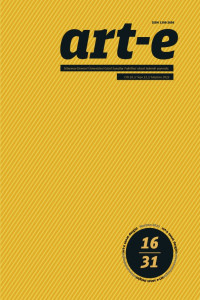Öz
Göstergebilim, göstergeleri incelemekte olan bilim dalı olarak açıklanmakta ve gösterge dizelerini inceleyen bilim dalı olarak tanımlanmaktadır. Dilimize göstergebilim olarak giren bu kavram İngilizce Semiyoloji kavramından gelmektedir. Göstergebilimsel analiz yönteminde, göstergede, gösteren ve gösterilen arasında bir ilişki kurulmakta ve bu durum anlamlama olarak isimlendirilmektedir. Anlamlama süreci, gösterenin göstergesini, gösterilen olarak zihinde biçimlendirilmesini sağlayan süreç olarak açıklanmaktadır. Barthes, göstergebilimsel analiz yönteminde, düz anlam ve yan anlam kuramlarını ortaya koymuştur. Düz anlam ve yan anlam kuramları, anlamlamanın bir parçası olarak şekillenmektedir. Araştırmada, örnekleme alınan ve goblen duvar halıları kullanan iki çağdaş kadın sanatçının eserleri, görünenin ardındaki derin anlamları/yan anlamları ortaya çıkarmayı amaçlayan göstergebilimsel analiz yöntemiyle incelenmiştir. Bu bağlamda, her iki sanatçının da goblen duvar halılarını kişisel belleklerinden elde ettikleri motivasyon ile sanatsal ürüne dönüştürdüğü tespit edilmiştir. Araştırmada, yapılan incelemelerde, her iki sanatçının da biçimsel olarak (gösterge) ortaya koydukları nesnelerin derin anlamında birtakım kurguların bulunduğu tespit edilmiş, göstergebilimsel analiz sayesinde bunları okumanın mümkün olduğu görülmüştür.
Anahtar Kelimeler
Göstergebilimsel Analiz Semiyotik Qualeasha Wood Louise Bourgeoise
Kaynakça
- Barthes, R. (1979). Göstergebilim İlkeleri, Çev. Berke Vardar-Mehmet Rifat. Ankara: Kültür Bakanlığı Yayınları.
- Bozdağ, L. (2013). “Biyoiktidar Kavramı ve Ötekileştirmenin İki Kadın Karakterde Temsili "Meryem Ana ve Berfo Ana", Sanat ve Tasarım Dergisi, Sayı 5, s. 152-171.
- Civelek, M. ve Türkay, O. (2020). “Göstergebilimin Kuramsal Açıdan İncelenmesine Yönelik Bir Araştırma”, Alanya Akademik Bakış Dergisi, Sayı 3, s. 771-784.
- Çağlar, B. (2012). Bir İletişim Biçimi Olarak Göstergebilim, LAÜ Sosyal Bilimler Dergisi, Sayı 2, s. 22-34 .
- Erişti, S. D. B. (2017). “Görsel Araştırma Yöntemleri Teori, Uygulama ve Örnek”, der. Suzan Duygu Erişti Bedir, Ankara: Pegem Yayınları.
- Güneş, A. (2013). “Göstergebilim Tarihi”, Humanities Sciences, Sayı 4, sf. 332-348.
- Karaman, E. (2017). “Roland Barthes ve Charles Sanders Peirce’in Göstergebilimsel Yaklaşımlarının Karşılaştırılması”, İstanbul Aydın Üniversitesi Dergisi, Sayı 2, sf. 25-36.
- Kılıç Gündüz, Y. (2019). Anselm Kiefer’ı̇n Eserlerinin Göstergebilimsel Çözümlemesi̇ ve Sanat Eğitimi Öğretim Programlarındaki Öğrenme Alanlarına Yansımaları, Yayınlanmamış Doktora Tezi, İzmir: Dokuz Eylül Üniversitesi, Eğitim Bilimleri Enstitüsü, Resim İş Öğretmenliği.
- Kıran, A. (1990). “Dilbilim-Göstergebilim İlişkileri”, Dilbilim Araştırmaları Dergisi, Sayı 1, sf. 51-62.
- Muñoz López, P. (2010). “Louise Bourgeois.” Revista Internacional de Culturas y Literaturas, number 9, p. 67-80.
- Ünal, M. F. (2016). “Göstergebilimin Serüveni”. Mütefekkir, Sayı 6, s. 379-398.
Öz
Semiotics is explained as the branch of science that examines indicators and is defined as the branch of science that studies indicator strings. This concept, which entered our language as ‘göstegebilim’, comes from the concept of English Semiology. In the semiotic analysis method, a relationship is established between the signifier and the signified, and this situation is called signification. The process of making sense is explained as the process that enables the signifier to be shaped in the mind as the signified. Barthes introduced denotation and connotation theories in the semiotic analysis method. Denotation and connotation theories are shaped as a part of signification. In the research, the works of two contemporary female artists, who were taken as a sample and using tapestry tapestries, were examined with the semiotic analysis method, which aims to reveal the deep meanings/connotations behind the visible. In this context, it was determined that both artists turned tapestry tapestries into artistic products with the motivation they obtained from their personal memories. In the research, it has been determined that there are some fictions in the deep meaning of the objects that both artists put forward formally (indicative), and it has been seen that it is possible to read them thanks to semiotic analysis.
Anahtar Kelimeler
Semiotic Analysis Semiotics Qualeasha Wood Louise Bourgeoise
Kaynakça
- Barthes, R. (1979). Göstergebilim İlkeleri, Çev. Berke Vardar-Mehmet Rifat. Ankara: Kültür Bakanlığı Yayınları.
- Bozdağ, L. (2013). “Biyoiktidar Kavramı ve Ötekileştirmenin İki Kadın Karakterde Temsili "Meryem Ana ve Berfo Ana", Sanat ve Tasarım Dergisi, Sayı 5, s. 152-171.
- Civelek, M. ve Türkay, O. (2020). “Göstergebilimin Kuramsal Açıdan İncelenmesine Yönelik Bir Araştırma”, Alanya Akademik Bakış Dergisi, Sayı 3, s. 771-784.
- Çağlar, B. (2012). Bir İletişim Biçimi Olarak Göstergebilim, LAÜ Sosyal Bilimler Dergisi, Sayı 2, s. 22-34 .
- Erişti, S. D. B. (2017). “Görsel Araştırma Yöntemleri Teori, Uygulama ve Örnek”, der. Suzan Duygu Erişti Bedir, Ankara: Pegem Yayınları.
- Güneş, A. (2013). “Göstergebilim Tarihi”, Humanities Sciences, Sayı 4, sf. 332-348.
- Karaman, E. (2017). “Roland Barthes ve Charles Sanders Peirce’in Göstergebilimsel Yaklaşımlarının Karşılaştırılması”, İstanbul Aydın Üniversitesi Dergisi, Sayı 2, sf. 25-36.
- Kılıç Gündüz, Y. (2019). Anselm Kiefer’ı̇n Eserlerinin Göstergebilimsel Çözümlemesi̇ ve Sanat Eğitimi Öğretim Programlarındaki Öğrenme Alanlarına Yansımaları, Yayınlanmamış Doktora Tezi, İzmir: Dokuz Eylül Üniversitesi, Eğitim Bilimleri Enstitüsü, Resim İş Öğretmenliği.
- Kıran, A. (1990). “Dilbilim-Göstergebilim İlişkileri”, Dilbilim Araştırmaları Dergisi, Sayı 1, sf. 51-62.
- Muñoz López, P. (2010). “Louise Bourgeois.” Revista Internacional de Culturas y Literaturas, number 9, p. 67-80.
- Ünal, M. F. (2016). “Göstergebilimin Serüveni”. Mütefekkir, Sayı 6, s. 379-398.
Ayrıntılar
| Birincil Dil | Türkçe |
|---|---|
| Bölüm | Makaleler |
| Yazarlar | |
| Erken Görünüm Tarihi | 29 Haziran 2023 |
| Yayımlanma Tarihi | 30 Haziran 2023 |
| Gönderilme Tarihi | 5 Mart 2023 |
| Kabul Tarihi | 4 Haziran 2023 |
| Yayımlandığı Sayı | Yıl 2023 Cilt: 16 Sayı: 31 |


